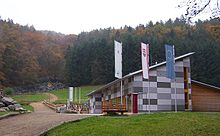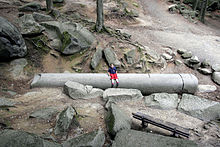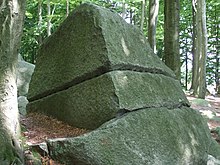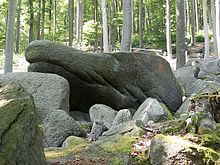Felsenmeer (Lautertal)
The sea of rocks on the Felsberg above Lautertal-Reichenbach in the Vorderen Odenwald is a rocky landscape made of dark gray quartz diorite (more precisely a hornblende - biotite diorite), which was created by the weathering of wool sacks . The sea of rocks was already used by the Romans and later by the local stonemasons for stone extraction. The stonemasons called it "Felsberg granite", which is no longer mined today. Today the Felsenmeer is a popular local recreation area and destination for families and hikers. It is located within the "Felsberg bei Reichenbach" nature reserve . At the upper end of the Felsenmeer there is a small spring whose rivulet flows between the rocks down into the valley and finally flows into the Graulbach.
Say
The legend of the Felsenmeer in Lautertal is about two giants who lived in the Reichenbach area. One on the Felsberg (rock stool), the other on the Hohenstein ( loach ). Their “giant empires” were separated by the Lautertal (Odenwald) . When they got into an argument, they threw boulders at each other. The "loach" had the advantage, he had more throwing material. So it happened that “Felshocker” was soon buried under the blocks; allegedly you can still hear him roaring underneath. The Hohenstein rock face is said to be the last wall of the other giant's house. This is how the formation of the sea of rocks was popularly explained.
Geological formation process
The oldest rocks in the Crystalline Odenwald are believed to be over 500 million years old. In the ancient times (Paleozoic), 380 to 340 million years ago, two great primary continents divided the planet. As a result of the continental drift, the two major continents moved towards each other and began to merge to form the supercontinent Pangea . The Odenwald is the result of the subduction of a smaller continent in the course of the merging of the two primary continents.
At that time the area of today's Odenwald was roughly at the level of the equator . The continent that was pushed into the subduction zone was melted in the zone of the upper mantle. The rock melts rose slowly from the depths, cooled in the earth's crust and formed plutonites .
The rocky seas on the Felsberg are made of quartz diorite. This crystalline rock belongs to the group of granitoids and consists of the minerals feldspar , pyroxene , hornblende and quartz . The quartz diorite formed at a depth of around 12 to 15 kilometers took a good 10 million years to cool down. Rock bodies that cool down shrink and tear. In the early Middle Ages, the Odenwald was inundated by a worldwide rise in sea levels and covered by deposits.
It took until the Tertiary to remove the several kilometers thick overburden. The ascent of this mighty quartz diorite intrusive body to the surface was supported by the collapse of the Rhine rift about 50 million years ago and the associated bending of the rift edges. Cracks and fissures in the rock deepened further and finally divided the rock into cuboid blocks, which were now exposed on the surface to the intense chemical weathering of the subtropical climate.
The weathering even reached deep-lying rock and caused the rock blocks to break down, mainly at the edges. The weathered debris, a mixture of gravel and clay minerals, the weathered gravel, gathered around the blocks .
During the last ice age around 12,000 years ago, the Odenwald was in a zone of permafrost and was not covered by the ice sheet. In the warmer seasons, the ground could thaw a little and water washed around the boulders. The granite gravel was washed away and the water collected in the cracks and crevices froze in the winter months.
With the receding of the frost line at the end of the Ice Age, the now exposed blocks began to move, slid down the valleys and formed the sea of rocks. The weathering process that gives the rock blocks their typical appearance is called wool sack weathering in geology .
The Roman work pieces on the sea of rocks
The unique selling point of the Odenwälder Felsenmeer are the Roman workplaces. The Romans left almost three hundred unfinished or damaged workpieces, spread over 15 workplaces, on the Felsberg. Since almost no tools, inscriptions or objects of daily use have been found, the time and duration of the Roman presence can only be roughly determined. After a detailed analysis of the material, the activity of the Romans on the Felsenmeer is limited to the second to fourth century.
The stone splitting technique with iron wedges was already very sophisticated in Roman antiquity. For this purpose, a series of tapered holes (so-called wedge pockets) are made in the stone. Then wedges are driven in.
However, the splitting effect is not generated by the edge of the wedge, but solely by the pressure on the flank of the wedge against the wedge pocket. It is therefore important that there is as seamless contact as possible between the flanks of the wedge and the side surfaces of the wedge pocket. This is one of the reasons why wedge pockets are usually chiseled out very carefully.
One effect that is feared by stone carvers is the so-called stitches . These are defects in the structure of the material that do not run through the entire block. If a sting was only detected immediately before completion of a workpiece, this usually led to the workpiece being abandoned - as in the case of the so-called coffin or very clearly recognizable in the case of the altar stone, which very clearly shows an unwanted separation. This may also be the reason why the completely finished giant column remained on site. Experts believe that the internal structure of the column did not allow it to be accurately divided. Rescuing the giant column undamaged from the sea of rocks would be a difficult task even with the technology of the 21st century.
Sawing with serrated saw blades is only possible with very soft rock. Normally, when stones sawing to a grinding process: The horizontal oscillating saw blade grinds with the addition of silica sand and water, a narrow groove out of the material. The sawing technique has the advantage that the natural ability of the stone to split does not have to be taken into account.
For the Felsberg it can be assumed that mobile saws were used. Since the Felsberg was an all-encompassing work area, the blocks were not brought to the saw, but the saw was set up over the blocks. The presumed sawing performance was 5 mm lowering per hour with a cutting length of 1 m.
natural reserve
The Felsenmeer records more than 100,000 visitors annually, who visit the Felsberg area mainly on the weekends. Conservationists criticize the fact that measures to guide visitors have so far had no effect. The damage caused by footpaths, rubbish and torn foliage (branches, trampled bushes) is clearly visible in the area of the main visitor flow and the core area of the Roman workplaces (giant column, pyramid, altar stone) and has been documented in various official reports for many years.
When the State of Hesse registered with the European Commission in 2000, the Felsberg near Reichenbach nature reserve became a Natura 2000 area. The Felsberg and with it the Felsenmeer are part of the Europe-wide ecological network, which is supposed to ensure the preservation of biological diversity better than before.
A description of the FFH area Felsberg (No. 6218-301) is documented in the standard data sheet excerpt from the Hessian Ministry for the Environment, Climate Protection, Agriculture and Consumer Protection (HMUKLV). Six habitat types for which acc. Habitats Directive reporting requirements are listed. The importance of the six habitat types is shown and the conservation status has been assessed.
- 8150 pebbly debris heaps in the mountainous areas of Central Europe (6.72 ha); Conservation status: average or limited
- 8310 caves not developed for tourism (<1.68 ha); Conservation status: average or limited
- 9110 Forest-Hainsimsen-Buchenwald (Luzulo-Fagetum) (38.64 ha); Conservation status: average or limited
- 9130 Woodruff beech forest (Galio odorati-Fagetum) (85.68 ha); Conservation status: good
- 9180 Tilio-Acerion ravine and slope mixed forests (1.68 ha); Conservation status: good
- 91E0 Alluvial forests with Alnus glutinosa and Fraxinus excelsior (Alno-Padion, Alnion incanae, Salicion albae) (<1.68 ha); Conservation status: good
In this assessment it is also stated that the destruction of the soil flora by the streams of visitors, footpaths and soil compaction leads to the endangerment of natural tree regeneration on more than 2 hectares.
Attractions
The Geopark Information Center of the Lautertal municipality, which deals with the geological history of the Geopark, the formation of the Felsenmeer, Roman history, the natural stone industry and the treasure trove of legends from the Odenwald, was opened in spring 2007. "Felsenmeer Information Center" has been a registered word and image trademark of the Lautertal community since February 2008 .
The Ohly Tower , a 27 m high observation tower made of granite, marks the highest point of the rock mountain. At 514 m above sea level, its summit is only 3 m lower than that of Melibokus . Today the Ohly Tower is a particularly striking example of the romanticizing historicism of the 19th century, whose models were medieval castles and other defensive structures. The tower is registered as a cultural monument in accordance with Section 2, Paragraph 1 of the Hessian Monument Act. However, the tower is not open to the public, extensive renovation measures are necessary in order to allow the visitor the all-round view from the tower platform.
The Siegfried spring at the foot of the Felsenmeer is one of the possible crime scenes of Siegfried's murder in the Nibelungenlied .
Special Roman work pieces
The giant column is 9.3 m long and weighs about 27.5 t. It's finished. Hardly any workpiece on the rock was described in more detail and examined in more detail. Three saw cuts that were started indicate that an attempt was made to split the column and move it away. On May 1, 1980, the giant column was so badly damaged by fire that a piece broke off. The Domstein at Trier Cathedral is a remnant of the giant column at the Felsenmeer.

Furthermore, five columns were used on the fountain house in the inner courtyard of Heidelberg Castle , in Mainz on the water basin on Schillerplatz and on the Oppenheim war memorial.
At the altar stone plate-like workpieces were abgekeilt by saw cuts were made up in plate thickness first, in which one could use the riving knife. The stone lifted off sideways from the end of the saw cut. Two saw cuts were made, but not completed.
The technique of splitting in the lifting gear (horizontal) can be seen very well on the pyramid . An egg-shaped block was split off on the head side up to the level of a stitch and then in the lifting passage.
The vessel is 12,35 meters, the workpiece having the longest continuous working edge. The wedge splitting is carried out properly, even if the mass of the rock has broken away a considerable part of the material and the "ship's bow" has been created.
The coffin was rendered unusable by an undercut during the wedge splitting, as the splitting followed the structure of the rock. The side surfaces are partially machined.
The circular plate protrudes conspicuously from the floor area and has a very evenly smoothed surface. Creating a circular workpiece was a very ambitious goal. However, a cut to around 7 o'clock meant the task.
More Attractions
Natural creations such as B. the giant armchair on the edge of the hiking path no. 4 or the crocodile on the edge of the hiking path no. 3. The exact location can be found on the information boards on site.
The Borstein is the beginning of a rock train (passage) that continues at Hohenstein, on the other side of the valley. The Borstein (4 m to 8 m high) and the Hohenstein (8 m to 14 m high) are ideal beginners' rocks for climbers and alpinists. Climbing and bouldering are allowed and there are a few hooks, especially the Hohenstein is suitable for climbing.
The geological-historical nature trail is part of the Bergstrasse-Odenwald Nature Park. In 1985 it was created with 16 information boards over a distance of around 2.5 km. It starts at the Römersteine parking lot.
Nature trail of the NABU bird protection group Reichenbach; Start from the Talweg or Borstein car park.
The owl tower - an old electrical substation - was taken over by the NABU bird protection group in 1979 and converted into a shelter for bats and owls, location: car park on Talweg.
Hiking trails
The Nibelungensteig - a 130-kilometer long- distance hiking trail that leads from Zwingenberg on the Bergstrasse to Freudenberg am Main - runs directly over the sea of rocks.
The Alemannenweg is a 144-kilometer-long hiking trail with predicate marks and leads directly through the upper area of the sea of rocks. The long circular route runs from Erbach via Bensheim-Auerbach , Frankenstein Castle and Veste Otzberg back into the Mümling valley to Michelstadt-Steinbach .
tourism
With the elevation to the Geopark numerous tourist offers at the Felsenmeer were created. The focus is on guided hikes on fixed dates or on demand as well as individually planned tours on various topics. There is a large influx of visitors, especially on sunny weekends and public holidays. Due to the current corona pandemic, there are certain rules that must be observed when staying at the Felsenmeer.
Individual evidence
- ↑ a b Wolf-Dieter Grimm, picture atlas of important monument rocks of the Federal Republic of Germany , ed. from the Bavarian State Office for Monument Preservation, Gesteins No. 020, Lipp-Verlag. Munich 1990. ISBN 3-87490-535-7
- ↑ Jutta Weber: The sea of rocks. Hot seam of the earth's crust. Geotop 2002. ( Memento of the original from November 22, 2011 in the Internet Archive ) Info: The archive link has been inserted automatically and has not yet been checked. Please check the original and archive link according to the instructions and then remove this notice. Geopark Bergstrasse-Odenwald
- ↑ Lautertal Community Foundation: The giant legend from the valley of the giants - how the sea of rocks came about
- ↑ Jutta Weber: Even the Romans used it: The sea of rocks near Lautertal in the Odenwald. In: Ernst-Rüdiger Look and Ludger Feldmann: Fascination Geology: The Most Important Geotopes in Germany , E. Schweizerbart'sche Verlagbuchhandlung Stuttgart 2006, ISBN 3-510-65219-3 , p. 66f.
- ↑ Henner Barth: Quartz diorite and granodiorite of the Felsberg train in the Bergstrasse Odenwald: their geological and petrological relationships with marble and amphibolite, gabbro and diorite , dissertation Heidelberg 1970, 144 pp.
- ↑ Jutta Weber: Even the Romans used it: The sea of rocks near Lautertal in the Odenwald. In: Ernst-Rüdiger Look and Ludger Feldmann: Fascination Geology: The Most Important Geotopes in Germany , E. Schweizerbart'sche Verlagsbuchhandlung Stuttgart 2006, ISBN 3-510-65219-3 , p. 67
- ↑ Standard data sheet for the FFH area Felsberg at the Hessian Nature Conservation Information System, status: 07/2011
- ↑ Standard data sheet , section 3.1
- ↑ Standard data sheet , Section 4.4
- ↑ https://www.felsenmeer-zentrum.de/downloads.html?matches=riesens%C3%A4ule&file=tl_files/userFiles/downloads/fiz_downloads/die_riesensaeule.pdf The history of the giant column , Felsenmeer information center
- ↑ Rules of conduct during Corona. Retrieved July 2, 2020 .
literature
- Klaus Fahlbusch, Werner Jorns , Gudrun Loewe and Josef Röder: The Felsberg in the Odenwald. With archaeological and geological contributions on the formation of the rocky seas and the technology of the Roman granite industry. Theiss, Stuttgart 1985, ISBN 3-8062-0792-5 ( Guide to Hessian Pre- and Early History 3).
- Holger Göldner u. W. Weyrauch: The Felsberg in the Odenwald. Guide sheet for the Roman stone industry near Lautertal-Reichenbach, Bergstrasse district. Wiesbaden 1989, ISBN 3-89822-080-X ( Archaeological Monuments in Hesse 80 )
- Károly Henrich: The Odenwälder Felsenmeer and the "forgotten" Felsberg nature reserve (PDF; 6.6 MB). Kassel: KOBRA, 2008.
- Marieta Hiller: Adventure Felsberg. Rock seas and Roman stones. Hiller, Glaser and Reiser. Lautertal 2002. ISBN 3-9806064-3-0
- Werner Jorns (Hrsg.): The Felsberg in the Odenwald , office for soil monument maintenance in the Reg.-Bez. Darmstadt, inventory of soil monuments, volume 1, Bärenreiter Verlag Kassel and Basel 1959
- Jörg Lindenthal: Cultural Discoveries. Archaeological monuments in Hessen. Jenior, Kassel 2004, pp. 139-141, ISBN 3-934377-73-4
- Felsberg bei Reichenbach - FFH standard extract from the Hessian Ministry for the Environment, Rural Areas and Consumer Protection (HMULV)
- Babist, J .; Vögler, A. & Gnirß, M. (2010): Traces of ancient stone mining near Heppenheim? - Experimental approaches to building a typology of wedge pockets. In: History sheets of the Bergstraße district, Volume 43, Verlag Laurissa, Lorsch; Pp. 235-272. ISSN 0720-1044 ( PDF )
Web links
- UNESCO Geo-Naturpark Bergstrasse-Odenwald with a brochure Geotop 2002 - Felsenmeer im Lautertal
- The Felsenmeer information center in Lautertal / Odenwaldes
- Aerial video of the Lauterbacher Felsenmeer , created by the Hessischer Rundfunk
Coordinates: 49 ° 43 ′ 26 ″ N , 8 ° 41 ′ 28 ″ E












